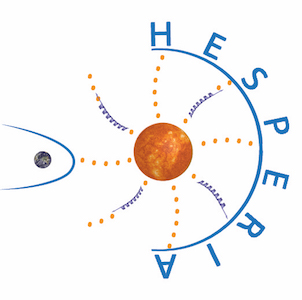SSA SPACE WEATHER COORDINATION CENTER - SSCC
We describe the two real-time prediction tools, that have been developed in the framework of the
HESPERIA HORIZON 2020 project based upon the proven concepts UMASEP and REleASE. A major impact on human
and robotic space exploration activities is the sudden and prompt occurrence of solar energetic ion events.
The fact that near-relativistic electrons (1 MeV electrons have 95% of the speed of light) travel faster than
ions (30 MeV protons have 25% of the speed of light) and are always present in Solar Energetic Particle (SEP) events
can be used to forecast the arrival of protons from SEP events with real-time measurements of near relativistic
electrons. The faster electrons arrive at L1 30 to 90 minutes before the slower protons. The Relativistic Electron
Alert System for Exploration (REleASE) forecasting scheme (Posner, 2007) uses this effect to predict the proton
flux by utilizing the actual electron flux and the increase of the electron flux in the last 60 minutes. In the
framework of the HESPERIA project, a clone of the REleASE system was built in the open source programming language
PYTHON. The same forecasting principle with use of the same forecasting matrices were in addition adapted to real-time
electron flux measurements from the Electron, Proton & Alpha Monitor (EPAM) onboard the Advanced Composition Explorer
(ACE). It is shown, that the REleASE forecasting scheme can be adapted to work with any near relativistic electron
flux measurements. Solar energetic particles (SEPs) are sometimes energetic enough and the flux is high enough to
cause air showers in the stratosphere and in the troposphere, which are an important ionization source in the
atmosphere. >500 MeV solar protons are so energetic that they usually have effects on the ground, producing what
is called a Ground Level Enhancement (GLE) event. Within the HESPERIA project a predictor of >500 SEP proton
events at the near-earth (e.g. at geostationary orbit) has been developed. In order to predict these events,
the UMASEP scheme (Núñez, 2011, 2015) has been used. UMASEP makes a lag-correlation of solar electromagnetic
(EM) flux with the particle flux at near-earth. If the correlation is high, the model infers that there is a
magnetic connection through which particles are arriving. If, additionally, the intensity of the flux of the
associated solar event is also high, then the UMASEP scheme issues a SEP prediction. In the case of the prediction
of >500 MeV SEP events, the implemented system, called UMASEP-500, correlates X-ray flux with each of the differential
proton fluxes measured by the GOES satellites. When the correlation estimation surpasses a threshold, and the associated
flare is greater than a specific X-ray peak flux, a >500 MeV SEP forecast is issued. Both forecasting tools are operational
under the HESPERIA server maintained at the National Observatory of Athens.

Contact
Olga Malandraki